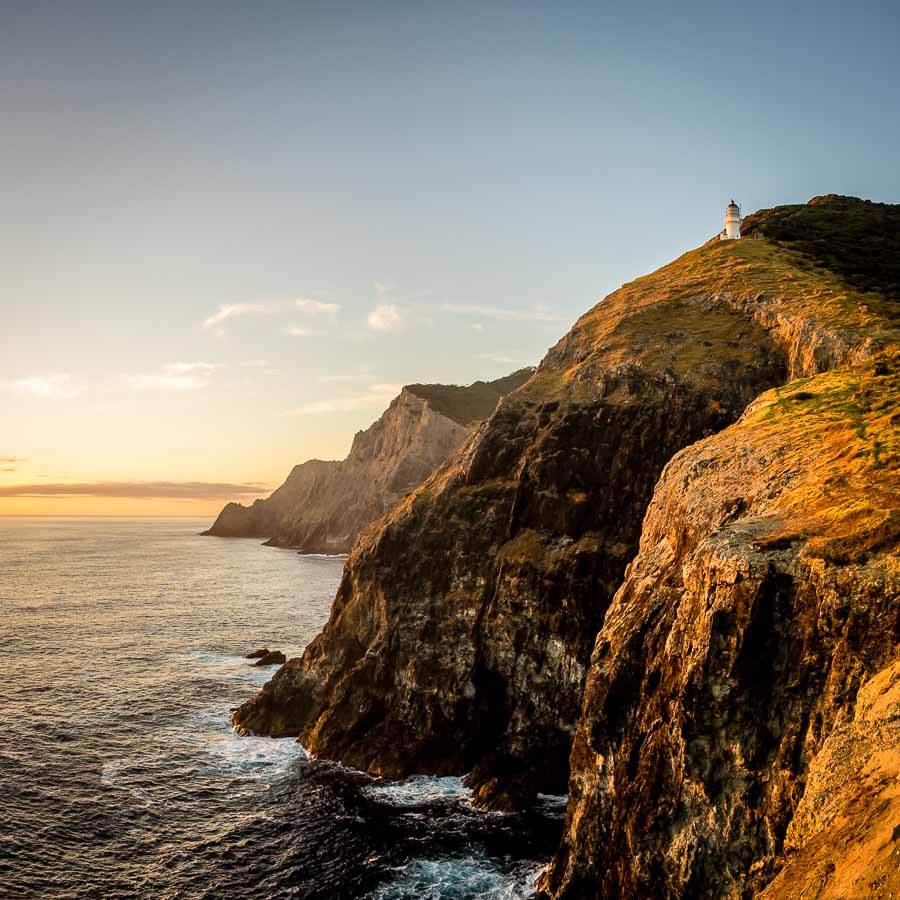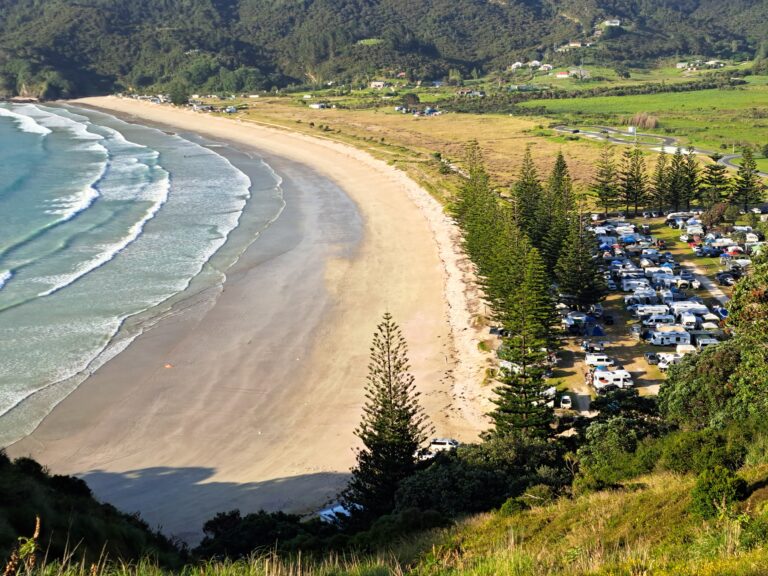How Hard Is The Cape Brett Lighthouse Hike? (My Experience)
I highly recommend the Cape Brett Lighthouse Track – It’s one of the best hikes I’ve ever done, but its also remote, challenging, and incredibly barren in the winterless north.
The Cape Brett hike is classified as ‘advanced’ on the Department of Conservation website and for good reason. The walk is 16.3km each way along undulating ridge lines, with constant ups and downs, and little protection from the elements. The hut is also known to often not have water, so you’ll need to pack in enough for 2 days. That said, if you pack well and take your time, I believe this is one of the most epic hikes in Northland.
But is it as hard as everyone say it is?
In this guide, I’ll share how i found the Cape Brett hike and give some recommendations on how hard it is, and what to watch out for when you tackle it.
Read more: In this article, I share my complete guide to the Cape Brett hike.
Table of Contents
Where is the Cape Brett Lighthouse?
The Cape Brett Lighthouse is located in the Bay of Islands, New Zealand. It is situated on the eastern side of the Cape Brett Peninsula, which is located at the end of the Oke Bay Track.
The starting point for the Cape Brett Lighthouse hike is at Rawhiti (Te Rawhiti Marae), which is located on the eastern side of the Bay of Islands. You can also start the hike from Deepwater Cove, which is accessible only by boat.
Here are the driving times to Cape Brett Lighthouse from nearby cities:
- From Auckland: approximately 3.5 hours
- From Russell: approximately 1 hour
- From Whangarei: approximately 1.5 hours
History of Cape Brett Lighthouse?
The Cape Brett Lighthouse was built in 1908 and completed in 1910 to guide ships through the dangerous waters of the Bay of Islands. The lighthouse was manned for many years until it was automated in 1978. Today, the lighthouse is a popular tourist attraction and hiking destination.
The old lighthouse keeper’s accomodation has been refurbished into a department of conservation hut, called the Cape Brett Hut. It is available for overnight stays and can accommodate up to 23 people. It is recommended to book in advance, as the hut can fill up quickly during peak summer.

Route Options
There are three main route options for hiking to the Cape Brett Lighthouse: from Oke Bay/ Te Rawhiti Marae, from Deepwater Cove via water taxi, or a mix of both. Each route has its own unique features and challenges.
From Te Rawhiti Marae / Oke Bay
This route starts from Te Rawhiti Marie and is approximately 16 km long. This route is the most challenging and takes around 8-10 hours to complete each way. The route is steep and rugged, with several hills to climb and descend. The trail is also quite exposed, so it is important to be prepared for changing weather conditions.
You’ll need a permit from the DOC website to access the first 10km of the track, from Te Rawhiti Marae to the Deep Water Cove turn-off as this part crosses private land.
From there, you’re back on DOC land and don’t need a permit.
From Deepwater Cove
The Deepwater Cove route is approximately 6 km long and takes around 4 hours to complete each way. This route is less challenging than full route but still requires a moderate level of fitness. The trail is well-maintained and offers stunning views of the Bay of Islands.
This cove is accessible by private boat or water taxi from Paihia.
A Mix of Both
For those who want to experience both routes, there is an option to hike from Rawhiti to Deepwater Cove and then take a water taxi back to Te Rawhiti marae. This route is approximately 22 km long and takes around 10-12 hours to complete, plus the time taken in the water taxi. This route offers a good balance of challenge and scenery.
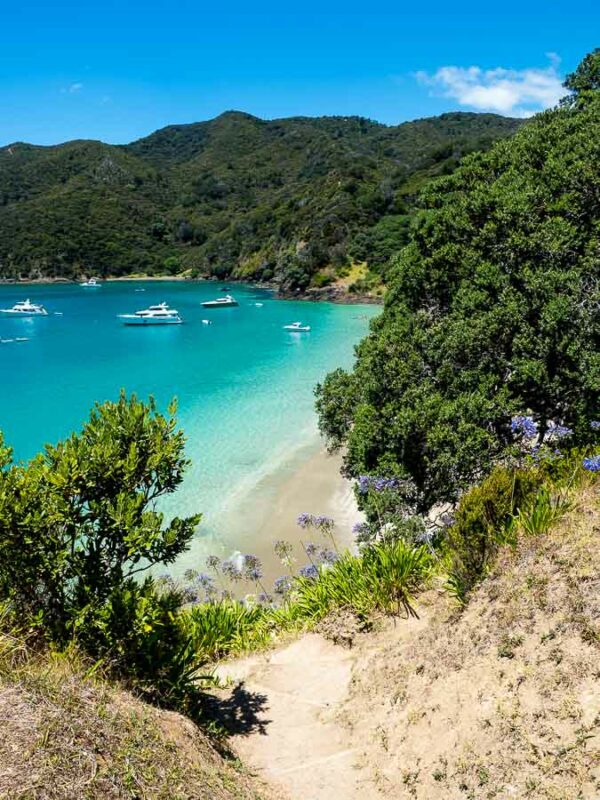


How Hard is the Cape Brett Lighthouse Hike?
The difficulty of the Cape Brett Lighthouse hike depends on several factors, such as your level of fitness, experience, and the time of year you visit. Here are some factors to consider:
My Take: I’m pretty fit and didn’t take much notice of the ‘Advanced’ rating on the DOC website. My mistake! This hike was hard going with a heavy pack on a scorching day and took me and my friend the best part of the full 8 hours. So my advice here is not to underestimate it.
For a Novice Hiker
For novice hikers, the Cape Brett Lighthouse hike can be quite challenging. The full route is particularly difficult, with several hills to climb and descend. The Deepwater Cove route is less challenging but still requires a moderate level of fitness.
That said, it’s only a 1 night hike and we’re talking generally mild northland conditions so you don’t need the best gear or the lightest pack.
My recommendation: I’d say this hike is a good option for novices, but maybe not if it’s your first overnight hike.
For Experienced Hikers
Experienced hikers will find the Cape Brett Lighthouse hike to be moderately challenging. The full 16km route is steep and rugged turning what would normally take 4-5 hours into closer to 7-8.
Recommendation: If you’re experienced you won’t have any issues here, but also don’t be cocky. pack well and leave plenty of time and daylight.
For Unfit People
For those who are unfit, the Cape Brett Lighthouse hike can be extremely challenging. The full route from te rawhiti s not recommended for those who do not have a good level of fitness, as it involves steep climbs and descents. You’ll also need to pack in your food and sleeping equipment so you’ll be doing these ascents and descents with a heavy pack.
Recommendation: If you’re not sure if you’ll be fit enough, i’d recommend taking the water taxi and starting and finishing the hike at Deep Water Cove.
During Peak Summer
During peak summer (December to February), the Cape Brett Lighthouse hike is often fully booked. This is the best time of year to do the hike (in my optionion) but you’ll be battling the heat and sun. Be prepared for 30-degree-plus days and little sun shelter. Also be prepared for there to be no water at the hut, so bring enough for both days hiking, cooking, cleaning, and drinking.
Difficulty Factors
Here are some factors that contribute to the difficulty of the Cape Brett Lighthouse hike:
| Difficulty Factor | Description |
|---|---|
| Distance | The distance of the hike depends on the route you choose. The full route is approximately 16 km, while the Deepwater Cove route is approximately 6 km each way |
| Duration | The duration of the hike also depends on the route you choose. The full route takes around 8-10 hours to complete each way, while the Deepwater Cove route takes around 4-6 hours. |
| Hills | Both routes involve several hills to climb and descend. The Marae route is particularly steep and rugged. |
| Weather | Weather conditions can change quickly on the Cape Brett Peninsula. It is important to be prepared for changing weather conditions and to bring appropriate gear. |
| Water Supply | There only water along the trail is at the Cape Brett brett hut and is rainwater collected from the hut roof. This often runs dry during summer, so it is important to bring enough water for the entire hike. |
| Terrain | The terrain of the Cape Brett Peninsula is rugged and exposed, with several hills to climb and descend. |
| Seasons | The best time to hike the Cape Brett Lighthouse is during the late summer (February to April), when the weather is mild and the crowds are smaller. |

Distance
The distance of the hike depends on the route you choose. The full route is approximately 32 km return, while the Deepwater Cove route is approximately 12 km.
Duration
The duration of the hike also depends on the route you choose. The full route takes around 6-8 hours each way, while the Deepwater Cove route takes around 3-5 hours each way.
I was doing the hike with a friend (so we were a group of two) and took almost the full recommended 8 hours. TBH i thought we’d move a bit fast but the hills and the heat got to us.
Hills
Both routes involve several hills to climb and descend. The full route is particularly steep and rugged.
I consider myself reasonably fit but struggled a lot more than i thought i would. depending on the weather some steep sections are very slipper (from either mud or dust) so be careful and wear good shoes
Weather
Weather conditions can change quickly on the Cape Brett Peninsula. It is important to be prepared for changing weather conditions and to bring appropriate gear.
When I did the walk it was blisteringly hot. I was very thankful for my wide brimmed hat and had packed enough clothes to cover up from the sun.
Likewise, i’ve heard of people getting caught in high winds and driving rain, so always pack warm and wet weather clothing just in case.
Water Supply
There is no water supply on the Cape Brett Peninsula, so it is important to bring enough water for the entire hike.
Cape Brett hut has rain water collection from the hut roof, however, in summer this is known to run out quickly.
When I did the hike there was no water at the hut. We packed 4L each, but had drunk most in the first day.
The second day we were VERY thirsty!
Terrain
The terrain of the Cape Brett Peninsula is rugged and exposed, with several hills to climb and descend.
Seasons
The best time to hike the Cape Brett Lighthouse is during the late summer (February to April), when the weather is mild and the crowds are smaller.
Seasons are a factor to consider because they can affect the weather and the number of hikers on the trail. When I hiked the Marae route during the late summer, the weather was mild and pleasant. There were also fewer hikers on the trail, which made it easier to find quiet spots to rest and enjoy the scenery.
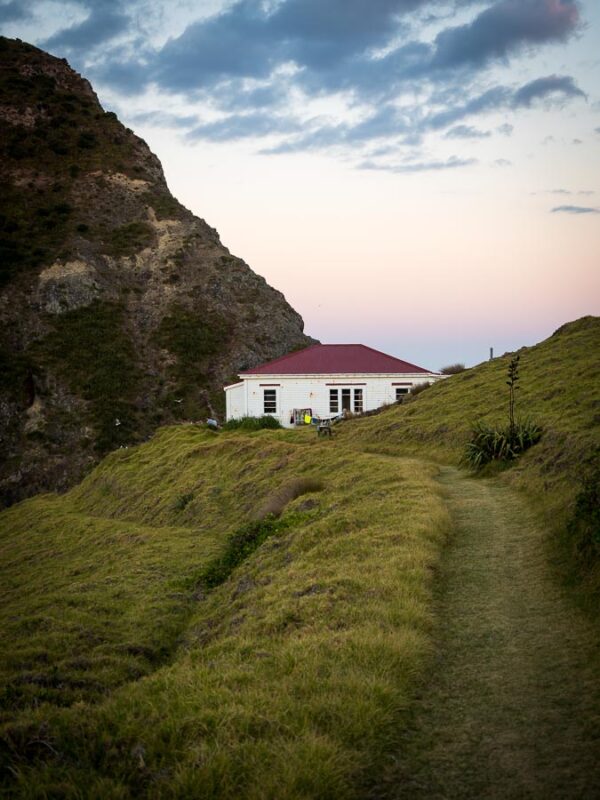



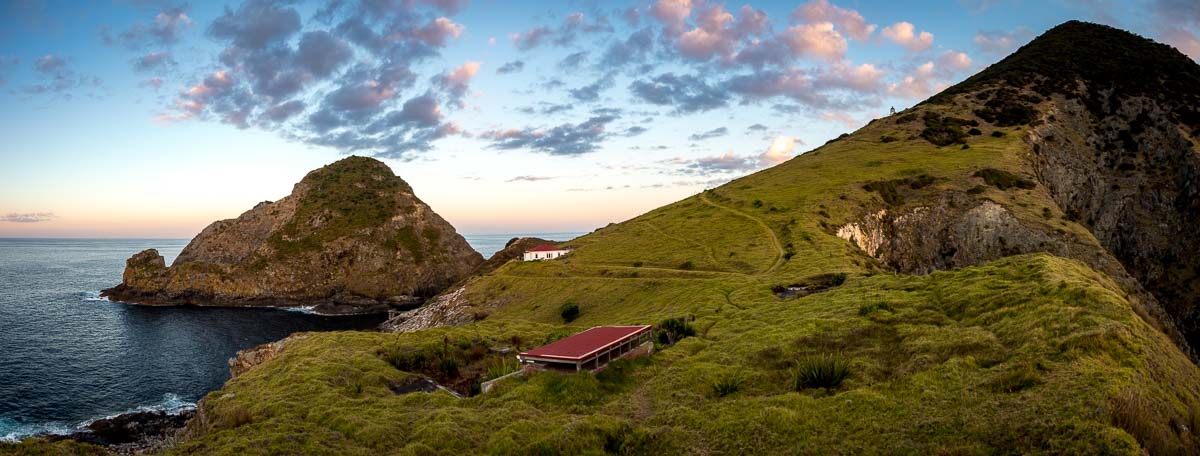
6 Tips to Make Your Cape Brett Hike More Enjoyable
Here are some tips to help you make the most of your Cape Brett Lighthouse hike:.
1. Pack Smart (and Light)
It is important to pack smart and bring only the essentials for the hike. Make sure you have enough water, food, and appropriate gear.
2. Stay Hydrated
There is no water supply on the Cape Brett Peninsula, so it is important to bring enough water for the entire hike.
3. Cover Up from the Sun
The Cape Brett Peninsula is quite exposed, so it is important to protect yourself from the sun. Wear a hat, sunscreen, and appropriate clothing.
4. Book for Late Summer
The best time to hike the Cape Brett Lighthouse is during the late summer (February to April), when the weather is mild and the crowds are smaller.
5. Be Prepared for Changing Weather
Weather conditions can change quickly on the Cape Brett Peninsula. It is important to be prepared for changing weather conditions and to bring appropriate gear.
6. Take Plenty of Photos!
The Cape Brett Peninsula offers stunning views of the Bay of Islands. Be sure to bring a camera and take plenty of photos!
Cape Brett Lighthouse Hike FAQ:
Here are some frequently asked questions about the Cape Brett Lighthouse hike:
Q. How Long Does the Cape Brett Walk Take?
A. The duration of the hike depends on the route you choose. It’s usually done as a 2 day one night hike. The full route takes around 8-10 hours each way to complete, while the Deepwater Cove route takes around 4-6 hours each way.
Q. How Hard is the Cape Brett Walk?
A. The difficulty of the Cape Brett Lighthouse hike depends on several factors, such as your level of fitness, experience, and the time of year you visit. The Department of Conservation website rates it an ‘advanced’ hike and having walked it myself (whilst being pretty fit) would agree that it’s a difficult walk.
Q. How Do I Get to Cape Brett Lighthouse?
A. The Cape Brett Lighthouse is located in the Bay of Islands, New Zealand. The best way to get there is by car to the trailhead, and then walk the 16km each way trail to the lighthouse. Alternatively, you can catch a watertaxi to deep water cove and walk the remaining 5km, or, if the tides allow it, taxi to an old concrete peir at the bottom of the cliffs below Cape Brett hut.
Q. When Was the Cape Brett Lighthouse Built?
A. The Cape Brett Lighthouse was built in 1910 to guide ships through the dangerous waters of the Bay of Islands. It was decomissioned and automated in 1978.
Q. How Much Does it Cost to Go to Cape Brett Track?
A. The cost of the Cape Brett Lighthouse hike varies depending on the route you choose. the hut pass is $15 and the track permit is $40. If you take the Deep Water Cove route, then you’ll save $40 on the permit but will need to pay at least $40 – $200 for a water taxi (dependingof course on how many people you share the boat with).
New Zealand Travel Planning Cheatsheet
🚑 Should I buy travel insurance for New Zealand?
100% YES! — New Zealand has “free” healthcare but it’s only for citizens. Tourists need travel insurance in case anything happens on your visit. Also be aware many policies won’t cover hiking as it’s a high risk activity! (that’s right, check the t&c’s on your complimentary credit card insurance)
I highly recommend World Nomads as you can get specific add-ons for the crazy activities you’re doing – and starts at just $7 a day!
🚙 Do you need to rent a car in New Zealand?
I’d reccommend it — Renting a car isn’t a necessity to get around in NZ with plenty of domestical flights and intercity busses. But, If you want to go on road trips or adventures outside of the major cities, you’ll need to rent a car. I always use Discover Cars for my rental bookings (it’s like Skyscanner for cars!) as they compare all availible providers for the best price.
Better yet, rent a van! This is the most cost effective way to see Aotearoa as you’re getting your transport and accomodation together as one! (Checkout my reccommended van rentals here)
📲 Will my phone work in New Zealand?
You’ll need to get a local SIM card when in New Zealand, which is super easy and doesn’t require ID. Spark generally has the best coverage and you can get pre-paid plans for around $30 for 30 days.
Alternativly – I now always use Airalo when travelling. This app generates an eSIM that will work the moment you touch down. It costs slightly more than a local SIM but the convenience is well worth it. You can signup here
💸How do you pay for thing in New Zealand?
Cash has gone out of fashion in New Zealand, so you’ll be able to pay for almost everything with EFTPOS / Debit / Credit Card. Paywave (contactless payments) is very common, but vendors who accept American Express cards are not (so bring a backup!).
I personally use Wise for all my international money needs as they only convert the funds when you may payment and offer a much better spread (margin on the true exhange rate) than the banks do. They also provide free deibit cards for your account!
🏩 What’s the best way to book my New Zealand accommodation?
My go-to for Kiwi hotels is Booking.com. For hostels, I use Hostel World. If you want a home-y feeling, check out AirBnB.. but don’t expect prices to be that much cheaper than hotels.
✈️ What’s the best site to buy flights to New Zealand?
For finding cheap flights, I recommend Skyscanner. Once you find the flight you’re looking for, I’d then suggest booking directly with the carrier (even if it costs a few $$ more than with one of the agreggators/agencies).
💧Can you drink the water in New Zealand?
Yes — everywhere in New Zealand you can drink the tap water. If you’re out hiking you can even drink the water from mountainous rivers and streams. I recommend a Brita Water Bottle and a packet of water purificiation tablets for long hikes and backcountry camping.
🎫 Do I need a visa for New Zealand?
NZ has a ‘traditional visa’ which is a document stamped in your passport allowing you to enter and stay in New Zealand for a specified period, while an “NZeTA” (New Zealand Electronic Travel Authority) is a travel authorization that allows certain passport holders to visit New Zealand without needing a separate visa – essentially a visa waiver for eligible travelers; meaning you need a full NZ visa if you don’t qualify for an NZeTA based on your passport and travel intentions.

